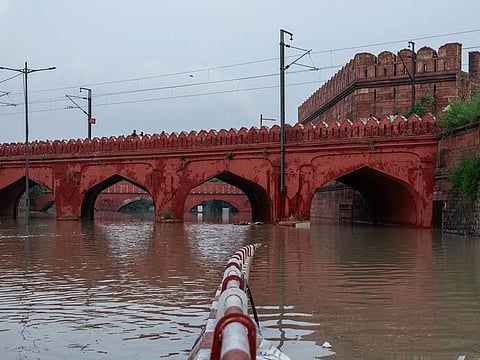India’s infrastructure challenges: Why the blame game never ends
From failed drainage systems to collapsing bridges, India’s infrastructure woes persist

Every leader in India, postures as a “vikas purush” (development man/woman) before every election. Some promise you airports, some talk about uninterrupted electricity. Everyone riffs on the trinity of “bijli, sadak, paani” (electricity, roads and water).
If you went by the iron clad promises made before every election you would reckon that India was now a developed paradise with clean water on tap, smooth expressways and 24/7 electricity.
The truth on development is somewhat different. At the first hint of monsoon rains the roof of the newly constructed (inaugurated by the Prime Minister, Narendra Modi on July 17) Veer Savarkar international airport in Port Blair collapsed.
The national capital New Delhi turned in to a giant lake fed by blocked city sewers — television journalists did bytes standing in fetid, filthy standing water heaving with water borne diseases.
The Yamuna flew above the danger mark inundating bridges since illegal construction had taken away its river bed and flowed alongside the Red Fort (revenge of the river denied its natural flood plain).
Every year before the monsoon the concerned authorities give solemn assurances that this time around drains have been cleaned and the monsoons won’t be marked by mayhem. At the first sign of waterlogging these civic worthies melt away the way Indian roads do only to surface next monsoon.
Against all insurmountable odds
Gurugoan — hailed as a millennium city — floats during the monsoons with gated compounds running on private electricity generators which copiously pollute the environment.
Apparently Gurugoan was developed without any drainage system at all so ultra expensive million plus cars floating on the highway are a common occurrence.
Civic apathy is a symbol of India. Mumbai, the capital of Maharashtra, may pay the highest income tax in the country; the Brihanmumbai Municipal Corporation (BMC) has a budget of ₹50 thousand crores but come monsoon and Mumbai stops. The roads are washed away and as the corporate heart of India stops.
Incalculable damages accrue. But, nothing ever changes as the mythical “spirit of Mumbai” is invoked by mealy mouthed politicians. Does the average Mumbaikar even have a choice except to show up at work against all insurmountable odds?
Infrastructure woes persist
This time around with Gujarat suffering from flash floods the sight of the Ahmedabad airport knee deep in water went viral on social media.
Pictures of cars floating in Junagadh did the rounds as the storm water drains collapsed across Gujarat. Dumad bridge in Vadodara built at the cost of nearly ₹54 crores and inaugurated in June this year resembled moon craters as it collapsed after overnight rains.
Black humour abounded as angry Indians coped, some saying the billionaire who had been allotted the Ahmedabad airport had shown forward thinking by building a seaport alongside the airport. The monsoons are a great equaliser in India as the super rich are forced to suffer along with the poor who live in slums.
So why do we Indians not care about and vote on infrastructure provision. Well the honest answer is extremely complicated. Indians feel no ownership to public infrastructure. You can see filthy graffiti, the ripped seats and stolen planters from public areas. Unless it’s chained down it’s bound to be stolen is a truism in our cities.
If we feel no ownership we can’t even take pride in the creation of world class infrastructure. Take railway carriages and how they are treated across classes by travellers. From public parks to government offices you will see people defacing walls, ripping out plants and misusing restrooms.
Worse — this “chalta hai” (anything goes) attitude is celebrated by even those who are meant to enforce some minimal standards in using tax payer created infrastructure assets.
VIP culture and civic neglect
Raj Thackeray, nephew of Balasaheb Thackeray, may not count for much in Maharashtra politics but, his party workers beat up those manning a public highway plaza because they dared ask Thackeray’s son to pay the toll on Sunday.
India has scores of very important people — ranging from judges to government officials — who take pride in being exempt from paying toll. Every toll gate has a billboard printed with those who are so important that they don’t need to be part of ordinary citizens and pay poll.
Yes that is right VVIPS in India would be horrified if they were treated like ordinary people and asked to pay for public resources. India has had cases of a judge setting up courtroom in railway stations and punishing railway officials because their honour was dissatisfied with the services provided to him.
Of course in the same railway station in Delhi a young teacher was electrocuted in front of her toddlers because nobody had bothered to fix a live wire. No lessons were learnt and nobody from the railways, police and emergency services were held accountable for the horrific death last month.
Indians who display utter contempt for civic sense miraculously transform when they are in places like Singapore where civic neglect is punished. Because we don’t care as voters, our leaders know they can literally get away with anything. So whether it’s a bridge collapse, awful roads and the worst polluted air in the world, we don’t punish leaders at the hustings for these.
Result we pay our taxes and yet have awful public infrastructure. Till we don’t care, our leaders won’t.
Sign up for the Daily Briefing
Get the latest news and updates straight to your inbox




